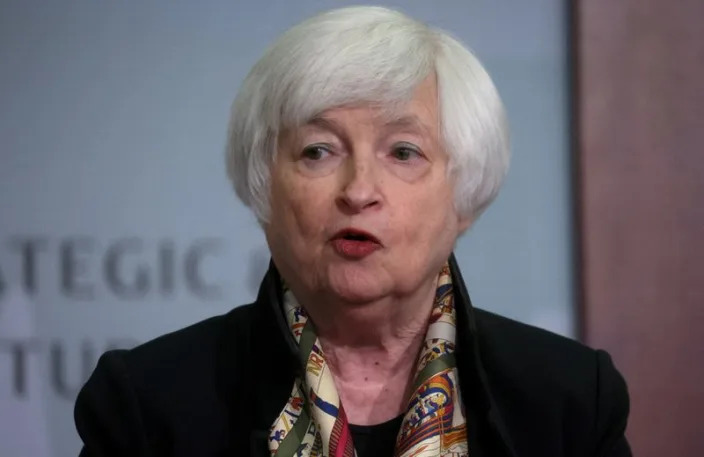
U.S. Treasury Secretary Janet Yellen speaks at the Center for Strategic and International Studies in Washington
Mon, February 20, 2023
By Davide Barbuscia and Saeed Azhar
NEW YORK (Reuters) - Bond investors are starting to trim holdings of U.S. debt to brace for a possible government default that they see as highly unlikely but potentially seismic for financial markets around the world.
The U.S. Treasury hit its $31.4 trillion borrowing limit last month. Unless congress raises or suspends that cap, the government could begin to default on bonds that underpin the global financial system and are considered some of the safest investments.
Some bond managers have started to adjust short-term exposure to Treasuries to avoid losses during the period when the government may exhaust its ability to pay its bills. Making preparations for a potential default is tricky, partly due to uncertainty over how much revenue the Treasury will collect from Americans filing income taxes in April.
Goldman Sachs Group Inc's asset management arm is minimizing its exposure to Treasuries that could be affected by the political standoff.
"You have to be thinking about what instruments you own, what maturities," said Ashish Shah, chief investment officer for public investing at Goldman Sachs Asset Management (GSAM), which oversees more than $2 trillion. "Just because you own an instrument like a T-bill doesn't mean that you sit there and let it mature -- you may want to trade out of it."
Investors need to actively manage their positions during a prolonged turbulent period in which borrowing negotiations could disrupt markets, Shah said. The Federal Reserve's path of interest-rate increases further complicates the situation, said Shah.
Last month, U.S. Treasury Secretary Janet Yellen said the government could only pay its bills through early June without increasing the limit, but some analysts have predicted that it will be the third or fourth quarter before the government exhausts its cash and borrowing capacity. The Congressional Budget Office warned it could occur between July and September.
The Treasury bills yield curve indicates investors are demanding higher returns to hold debt due in August, signaling that it is perceived to be riskier than other maturities.
Wider spreads between Treasury bill yields and matched-maturity overnight index swap (OIS) rates - a gauge for future policy rates - in mid-August reflect views that bills maturing then carry a higher risk of a missed payment, said Jonathan Cohn, head of rates trading strategy at Credit Suisse in New York.
"A kink (in the Treasury bill curve) has become evident through mid-August where the latest 6-month bill issues mature," he said.
Graphic: Treasury bills curve, https://fingfx.thomsonreuters.com/gfx/mkt/xmpjkrzbwvr/Z7FWt-treasury-bills-curve.png
Standoffs over the debt limit in the last decade have largely been resolved without causing major financial turmoil. But Republican lawmakers with a narrow majority in the U.S. House of Representatives could resist a compromise with Democratic President Joe Biden, which in turn could roil markets.
Bond investors are navigating uncertainty around what they're calling the X-date, when the government can no longer meet its payments. An actual default is considered an event with a low probability but potentially high impact. It could send shockwaves through global markets and raise borrowing costs for both the U.S. government and corporations.
"The probability of a default is very low, but I'm okay telling my clients to avoid T bills with a six-month maturity ... That is probably the most concrete way in which we're approaching this," said Ed Al-Hussainy, senior interest rate strategist at Columbia Threadneedle.
Al-Hussainy may also buy Japanese yen, because a U.S. default would likely challenge the safe-haven status of the U.S. dollar and spur investors to seek protection in other currencies, he said.
(Reporting by Davide Barbuscia and Saeed Azhar; Editing by Lananh Nguyen and David Gregorio)
No comments:
Post a Comment